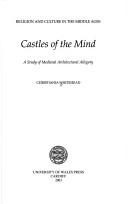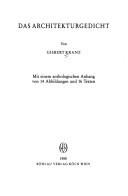| Listing 1 - 10 of 21 | << page >> |
Sort by
|
Book
ISBN: 9789085067931 9085067936 Year: 2009 Volume: 2 Publisher: Amsterdam SUN
Abstract | Keywords | Export | Availability | Bookmark
 Loading...
Loading...Choose an application
- Reference Manager
- EndNote
- RefWorks (Direct export to RefWorks)
Book
Year: 1987 Publisher: Genève Slatkine
Abstract | Keywords | Export | Availability | Bookmark
 Loading...
Loading...Choose an application
- Reference Manager
- EndNote
- RefWorks (Direct export to RefWorks)
Architecture [Medieval ] --- Literature [Medieval ] --- Gardens [Medieval ] --- Architecture in literature
Book
ISBN: 8427605439 Year: 1981 Volume: vol 15 Publisher: Madrid Editora nacional
Abstract | Keywords | Export | Availability | Bookmark
 Loading...
Loading...Choose an application
- Reference Manager
- EndNote
- RefWorks (Direct export to RefWorks)
Arabic literature
---
-Architecture in literature
---
#BIBC:ruil
Book
ISBN: 9782503579740 2503579744 Year: 2019 Publisher: Turnhout Brepols
Abstract | Keywords | Export | Availability | Bookmark
 Loading...
Loading...Choose an application
- Reference Manager
- EndNote
- RefWorks (Direct export to RefWorks)
Die Untersuchung stellt sich die Frage, weshalb die ,Periegesis Hellados‘ des Pausanias aus dem 2. Jahrhundert n. Chr. so häufig Siedlungen und Gebäude im Zustand der Zerstörung thematisiert. Die ,Periegesis Hellados‘ unternimmt eine räumlich organisierte Zusammenstellung von Wissen, insbesondere zur myth-historischen Vergangenheit sowie zu den Kulten der Griechen, und schreibt sich auf diese Weise in zentrale Diskurse der Zweiten Sophistik ein. Die prominente Rolle, die zerstörte Architektur im Werk des Pausanias spielt, wurde bislang nicht systematisch analysiert. Hier setzt die Untersuchung an. Alle einschlägigen Textpartien werden vorgelegt und innerhalb zweier entscheidender Bezugshorizonte ausgewertet: zum einen im Rahmen der inhärenten Logik der ,Periegesis Hellados‘, zum anderen im Verhältnis zum zeitgenössischen Ruinendiskurs. Welch essenziellen Stellenwert die Ruine für die Programmatik und das Selbstverständnis des Textes einnimmt, kann auf diese Weise erstmals umfassend nachgezeichnet werden.
Ruins in literature. --- Architecture in literature. --- Pausanias, --- Criticism and interpretation. --- Greece --- Description and travel

ISBN: 0708317944 Year: 2003 Volume: *2
Abstract | Keywords | Export | Availability | Bookmark
 Loading...
Loading...Choose an application
- Reference Manager
- EndNote
- RefWorks (Direct export to RefWorks)
Allegorie --- Allegory --- Allégorie --- Architecture dans la littérature --- Architecture in literature --- Architectuur in de literatuur --- Allegory. --- Architecture and literature --- Architecture in literature. --- Literature, Medieval --- History --- History and criticism. --- Literature [Medieval ] --- History and criticism --- To 1500
Book
ISBN: 9782745314369 274531436X Year: 2007 Volume: 102 Publisher: Paris Honoré Champion
Abstract | Keywords | Export | Availability | Bookmark
 Loading...
Loading...Choose an application
- Reference Manager
- EndNote
- RefWorks (Direct export to RefWorks)

ISBN: 3412063878 Year: 1988 Volume: vol 39
Abstract | Keywords | Export | Availability | Bookmark
 Loading...
Loading...Choose an application
- Reference Manager
- EndNote
- RefWorks (Direct export to RefWorks)
Architecture dans la littérature --- Architecture in literature --- Architectuur in de literatuur --- Poetry --- -Poems --- Verses (Poetry) --- Literature --- History and criticism --- Philosophy --- -History and criticism --- Criticism
Book
ISBN: 9004345388 9789004345386 9789004345379 900434537X Year: 2017 Publisher: Leiden Boston
Abstract | Keywords | Export | Availability | Bookmark
 Loading...
Loading...Choose an application
- Reference Manager
- EndNote
- RefWorks (Direct export to RefWorks)
In A Sense of the City , Gala Maria Follaco examines Nagai Kafū’s (1879-1959) literary construction of urban spatialities from late Meiji through the early Shōwa period. She argues that Kafū’s urban critique was based on his awareness of the cultural sedimentation of the cityscape and of the complex relationship that it bore with the historical framework of modern Japan. With the overall aim to define Kafū’s position within pre-war Japanese literature, Follaco touches upon key issues such as memory, class difference, and language ideologies; draws connections between his sojourn abroad and strategies of “mapping” the city of Tokyo in his literature; and takes into account works previously understudied, including his biography of Washizu Kidō and his photographs.
Cities and towns in literature. --- Space (Architecture) in literature. --- Nagai, Kafū, --- Nagai, Sōkichi --- Kafu, Nagai --- 永井荷風 --- 永井苛風 --- 永井荷风 --- 永开荷風 --- Criticism and interpretation.
Book
ISBN: 0814733271 9780814732489 0814732488 9780814733271 9780814732465 0814732461 9780814732472 081473247X Year: 2011 Publisher: New York New York University Press
Abstract | Keywords | Export | Availability | Bookmark
 Loading...
Loading...Choose an application
- Reference Manager
- EndNote
- RefWorks (Direct export to RefWorks)
Sites Unseen examines the complex intertwining of race and architecture in nineteenth and early-twentieth century American culture, the period not only in which American architecture came of age professionally in the U.S. but also in which ideas about architecture became a prominent part of broader conversations about American culture, history, politics, and—although we have not yet understood this clearly—race relations. This rich and copiously illustrated interdisciplinary study explores the ways that American writing between roughly 1850 and 1930 concerned itself, often intensely, with the racial implications of architectural space primarily, but not exclusively, through domestic architecture.In addition to identifying an archive of provocative primary materials, Sites Unseen draws significantly on important recent scholarship in multiple fields ranging from literature, history, and material culture to architecture, cultural geography, and urban planning. Together the chapters interrogate a variety of expressive American vernacular forms, including the dialect tale, the novel of empire, letters, and pulp stories, along with the plantation cabin, the West Indian cottage, the Latin American plaza, and the “Oriental” parlor. These are some of the overlooked plots and structures that can and should inform a more comprehensive consideration of the literary and cultural meanings of American architecture. Making sense of the relations between architecture, race, and American writing of the long nineteenth century—in their regional, national, and hemispheric contexts—Sites Unseen provides a clearer view not only of this catalytic era but also more broadly of what architectural historian Dell Upton has aptly termed the social experience of the built environment.
American literature --- Architecture and literature. --- Race in literature. --- Architecture in literature. --- Literature --- History and criticism. --- Literature and architecture --- 19th century --- History and criticism --- Architecture in literature --- Race in literature --- Architecture and literature --- 20th century --- Chesnutt, Charles Waddell --- Criticism and interpretation --- Torres, Olga Beatriz --- Wright, Frank Lloyd --- Biggers, Earl Derr --- Downing, Andrew Jackson --- Crafts, Hannah
Book
ISBN: 9052811679 9789052811673 Year: 2000 Volume: 9de jaarg., nr 2 vol. 9, nr 2 Publisher: Antwerpen : Dedalus,
Abstract | Keywords | Export | Availability | Bookmark
 Loading...
Loading...Choose an application
- Reference Manager
- EndNote
- RefWorks (Direct export to RefWorks)
Art --- Dutch literature --- Antwerp --- Architecture --- Bouwkunst --- Stedenbouw --- Urbanisme --- art [fine art] --- Broucke, Koen --- Mullem, Van, Jean-François --- Lagrange, Thierry --- Donckers, Niels --- Goiris, Geert --- Dedobbeleer, Koenraad --- Architecture in literature. --- art [discipline] --- Environmental planning --- comprehensive plans [reports] --- Political philosophy. Social philosophy --- utopias
| Listing 1 - 10 of 21 | << page >> |
Sort by
|

 Search
Search Feedback
Feedback About UniCat
About UniCat  Help
Help News
News